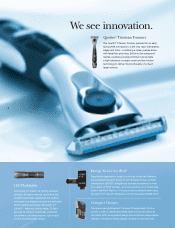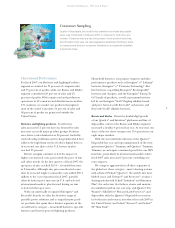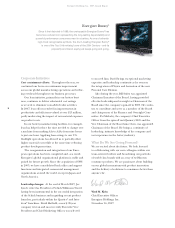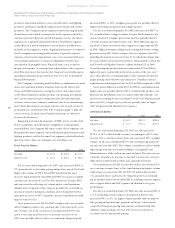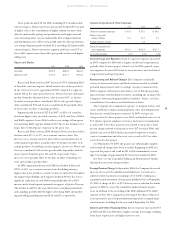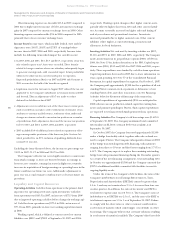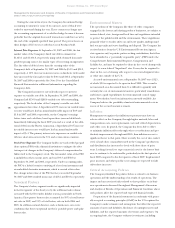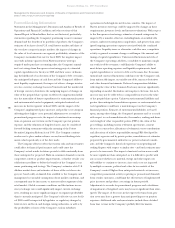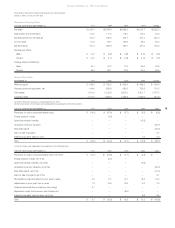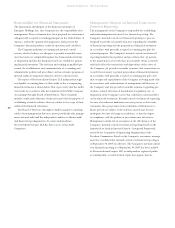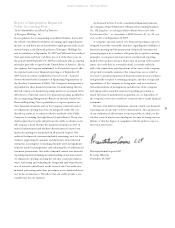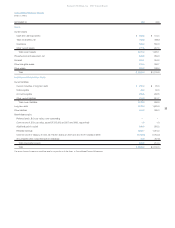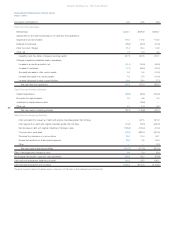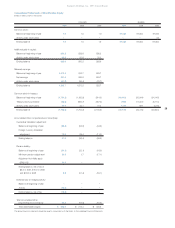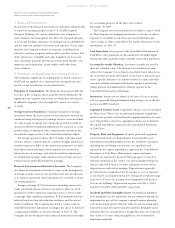Energizer 2007 Annual Report Download - page 18
Download and view the complete annual report
Please find page 18 of the 2007 Energizer annual report below. You can navigate through the pages in the report by either clicking on the pages listed below, or by using the keyword search tool below to find specific information within the annual report.
16
Energizer Holdings, Inc. 2007 Annual Report
During the current fiscal year, the Company discontinued hedge
accounting treatment for some of its contracts, most of which were
settled or unwound during the year. These contracts no longer met
the accounting requirements of a cash flow hedge because it became
probable that the original forecasted transactions would not occur by
the end of the originally specified time period. The pre-tax losses on
these hedges of $2.5 were recorded in Cost of Products Sold.
Interest Rate Exposure At September 30, 2007 and 2006, the fair
market value of the Company’s fixed rate debt is estimated at
$1,423.1 and $1,454.8, respectively, using yields obtained from inde-
pendent pricing sources for similar types of borrowing arrangements.
The fair value of debt is lower than the carrying value of the
Company’s debt at September 30, 2007 and 2006 by $51.9 and $30.2,
respectively. A 10% decrease in interest rates on fixed-rate debt would
have increased the fair market value by $40.4 and $46.2 at September
30, 2007 and 2006, respectively. See Note 10 to the Consolidated
Financial Statements for additional information regarding the
Company’s debt.
The Company has interest rate risk with respect to interest
expense on variable rate debt. At September 30, 2007 and 2006, the
Company had $150.0 and $288.6 variable rate debt outstanding,
respectively. The book value of the Company’s variable rate debt
approximates fair value. A hypothetical 10% increase in variable inter-
est rates would have had an annual unfavorable impact of $0.9 and
$1.8 in 2007 and 2006, respectively, on the Company’s earnings
before taxes and cash flows, based upon these year-end debt levels.
Immediately following the fiscal 2007 year-end as a result of the addi-
tional debt from the Playtex transaction, a hypothetical 10% increase
in variable interest rates would have had an annual unfavorable
impact of $5.4. The primary interest rate exposures on variable rate
debt are short-term rates in the U.S. and certain Asian countries.
Stock Price Exposure The Company holds a net-cash settled prepaid
share option (PSO) with a financial institution to mitigate the after-
tax impact of changes in the Company’s deferred compensation lia-
bilities tied to the Company’s stock. The fair market value of the PSO
is included in other current assets and was $59.3 and $50.8 at
September 30, 2007 and 2006, respectively. Under accounting rules,
the PSO is a hybrid security consisting of a host loan instrument and
an embedded derivative instrument, which is carried at fair value.
The change in fair value of the PSO for the year ended September
30, 2007 and 2006 resulted in income of $23.2 and $10.8, respectively.
Seasonal Factors
The Company’s battery segment results are significantly impacted
in the first quarter of the fiscal year by the additional sales volume
associated with the December holiday season, particularly in North
America. First quarter battery sales accounted for 30% of total battery
net sales in 2007, and 31% of total battery sales in both 2006 and
2005. In addition, natural disasters, such as hurricanes, can create
conditions that drive exceptional needs for portable power and spike
battery sales.
Environmental Matters
The operations of the Company, like those of other companies
engaged in the battery and shaving products businesses, are subject to
various federal, state, foreign and local laws and regulations intended
to protect the public health and the environment. These regulations
primarily relate to worker safety, air and water quality, underground
fuel storage tanks and waste handling and disposal. The Company has
received notices from the U.S. Environmental Protection Agency,
state agencies and/or private parties seeking contribution, that it has
been identified as a “potentially responsible party” (PRP) under the
Comprehensive Environmental Response, Compensation and
Liability Act, and may be required to share in the cost of cleanup with
respect to seven federal “Superfund” sites. It may also be required to
share in the cost of cleanup with respect to two state-designated sites
or other sites outside of the U.S.
Accrued environmental costs at September 30, 2007 were $12.5,
of which $2.6 is expected to be spent in fiscal 2008. This accrual is
not measured on a discounted basis. It is difficult to quantify with
certainty the cost of environmental matters, particularly remediation
and future capital expenditures for environmental control equip-
ment. Nevertheless, based on information currently available, the
Company believes the possibility of material environmental costs in
excess of the accrued amount is remote.
Inflation
Management recognizes that inflationary pressures may have an
adverse effect on the Company, through higher material, labor and
transportation costs, asset replacement costs and related depreciation,
and other costs. In general, the Company has been able to offset
or minimize inflation effects through other cost reductions and pro-
ductivity improvements through mid-2005, thus inflation was not a
significant factor to that point. More recently, the cost of zinc, nickel,
steel, oil and other commodities used in the Company’s production
and distribution has increased to levels well above those of prior
years. Looking forward, we expect material costs for the battery busi-
ness to continue to be unfavorable, particularly in the first quarter of
fiscal 2008 compared to the first quarter of fiscal 2007. Implemented
price increases and other product cost savings are expected to fully
offset these increases.
Critical Accounting Policies
The Company identified the policies below as critical to its business
operations and the understanding of its results of operations. The
impact and any associated risks related to these policies on its busi-
ness operations is discussed throughout Management’s Discussion
and Analysis of Results of Operations and Financial Condition where
such policies affect the reported and expected financial results.
Preparation of the financial statements in conformity with gener-
ally accepted accounting principles (GAAP) in the U.S. requires the
Company to make estimates and assumptions that affect the reported
amounts of assets and liabilities, disclosure of contingent assets and
liabilities, and the reported amounts of revenues and expenses. On
an ongoing basis, the Company evaluates its estimates, including
Management’s Discussion and Analysis of Results of Operations and Financial Condition
(Dollars in millions, except per share and percentage data)


